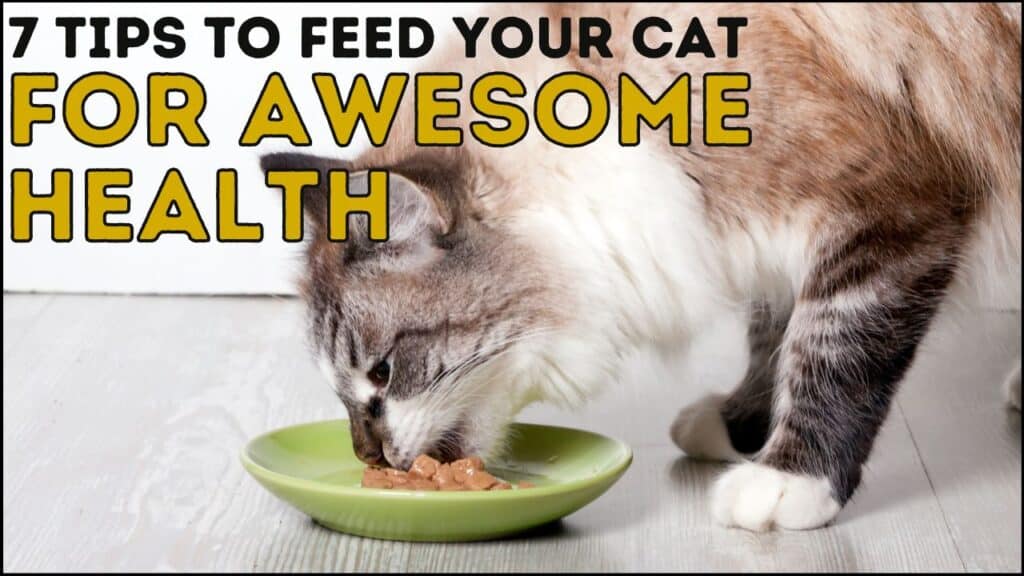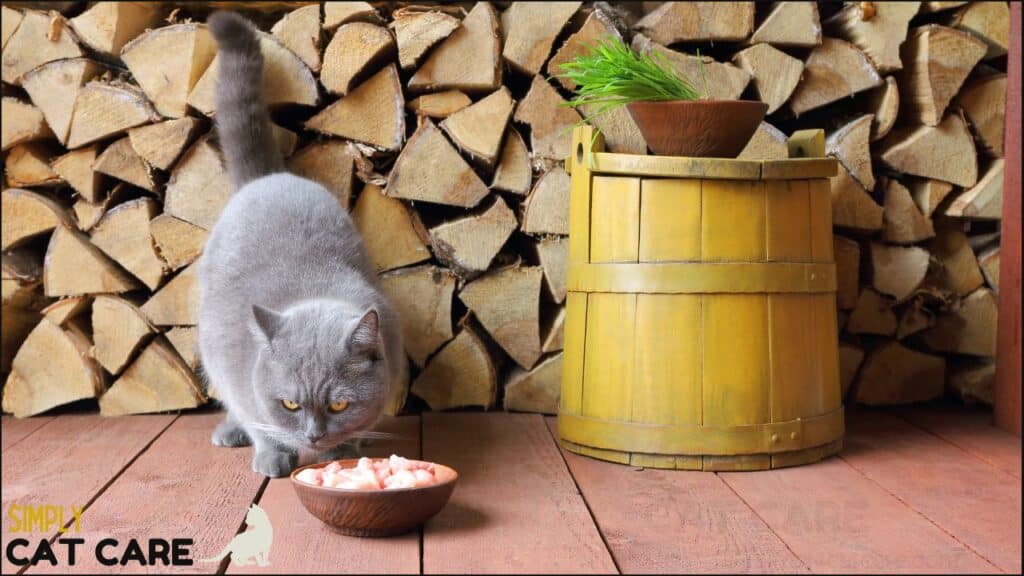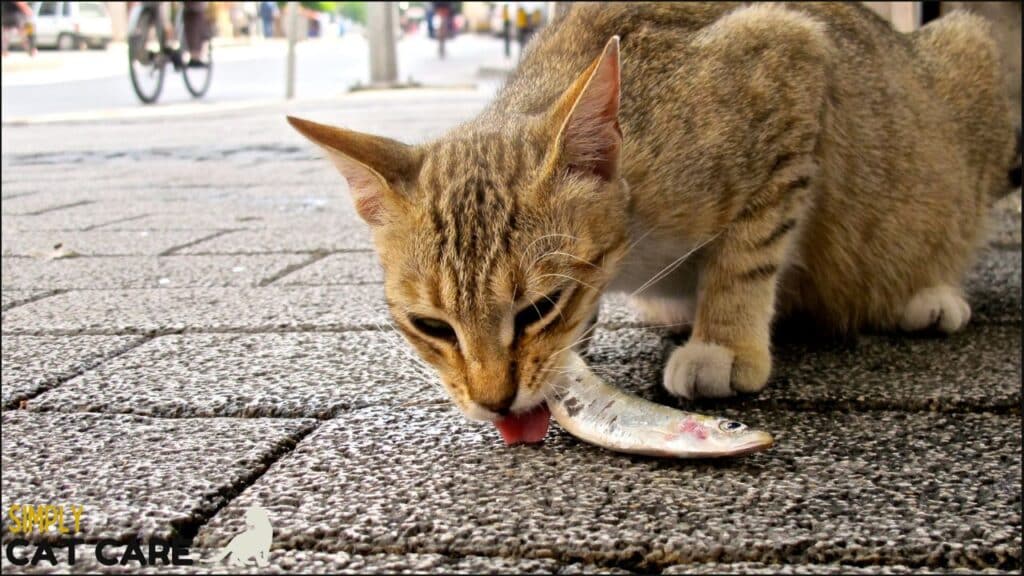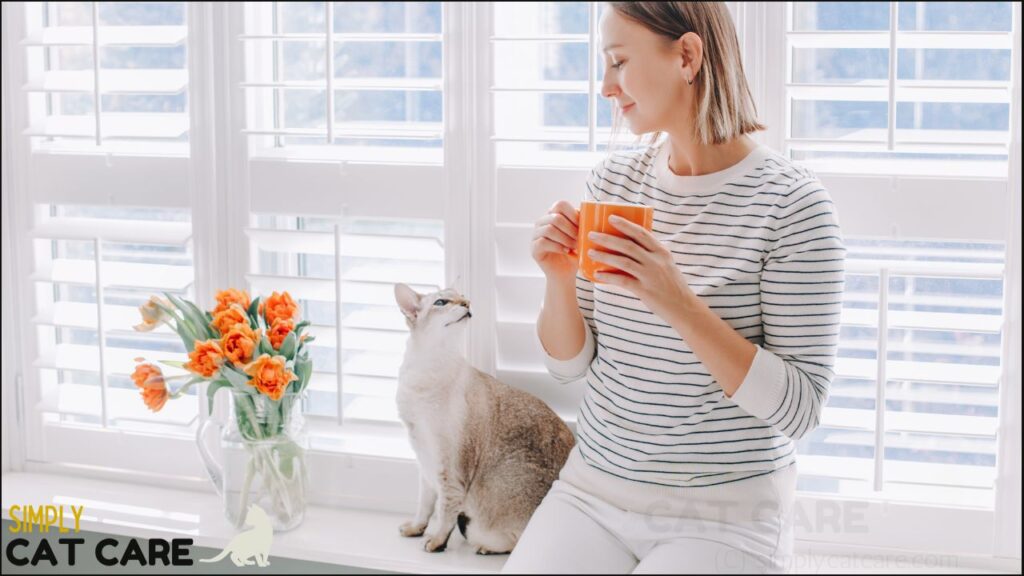Disclaimer: As a Chewy and Amazon affiliate, I earn from qualifying purchases. This does not impact our reviews and comparisons.
What do you feed your cat for top health?
Cats are carnivores. They evolved off a diet of prey.
Wet cat food is your best choice to reflect your cats evolved needs. Choose cat food that meets AAFCO’s guidelines as a complete meal.
In this article, I’ll give you my 7 tips to feed your cat for awesome health.
This will cover what your cat needs, and what they don’t.
I am not a veterinarian and I recommend seeking the advice of a vet for any further questions. This article is not intended as medical advice.
Let’s start.

7 Tips to Feed Your Cat for Awesome Health
1. Choose Low Carb Cat Food
Cats do not need any carbs.
Sources include:
- Wheat
- Rice
- Corn
- Potato
- Beans
- Lentils
- Fruit
- Vegetables
- Sugar
- Starch
Cats aren’t adapted to diets high in carbs.
Whilst cats can digest small amounts, too much leads to diarrhea and flatulence.
Cats don’t have enough enzymes to digest carbs. Their bodies can’t control blood sugar with high carb intakes.
AAFCO have no guidelines for carbs. Meaning, there is no need to have any in your cats diet (although it’s hard and unnecessary to eliminate all carbs).
For best health, choose cat food low in carbs. Use a carb dry matter calculator to check.
Choose cat food with fewer than 15% carbs on a dry matter basis.
Learn More:
2. Feed Your Cat a High Protein Diet
Cats prefer high protein diets.
When given a choice, cats prefers a diet with ~50% protein. This reflects what they get in the wild.
A cat’s diet needs to be at least 16% protein by energy. This is higher than humans, who only need 8% protein as a minimum.
When given a low protein diet, cats can’t prevent the loss of protein to conserve protein.
A cat’s weight will fall if not getting enough protein due to lost muscle.
Of the 20 amino acids, 10 are ‘essential amino acids. Meat products are highest in essential amino acids.
This includes:
- Salmon
- Chicken
- Beef
- Turkey
- Lamb
Again, it’s best to use a dry matter calculator to check protein content.
AAFCO recommend choosing cat food with at least 30% protein dry matter. More protein may improve taste for picky cats.
3. Feed Your Cat Enough Taurine
Taurine is an essential amino acid that must be provided to keep your cats heart and eyes healthy.
There are 10 essential amino acids in your cat’s diet.
That means you need to give them to your cat.
Humans don’t need taurine, but cats do.
In humans, taurine is a non-essential amino acid. This means our body makes its own taurine.
Taurine is only found in animal products and if not supplemented will lead to a taurine deficiency.
Taurine produces bile salts, which help digest fats and fat-soluble vitamins.
A range of taurine deficiency conditions exists which include liver fat accumulation and degeneration of the retina.
Blindness, for example, can be a sign of taurine deficiency.
Feline taurine retinopathy or feline central retinal degeneration (FCRD) are the clinical signs of a taurine deficiency.
Thousands of cat deaths from heart conditions occurred in the 1980s due to poor quality food that wasn’t supplemented with enough taurine.

4. Feed Your Cat a High-Fat Diet
Cats need fat for energy.
It also helps with taste.
Cats need a small amount of essential fatty acid arachidonic acid (AA) in their diet.
Unlike humans, cats can’t convert linoleic acid to AA. Plant oils like sunflower oil are high in linoleic acid, hence don’t benefit cats.
AA is needed for normal inflammatory processes (involved in healing).
Cats also need a small amount of omega 3 fatty acids from eicosapentaenoic acid (EPA) and docosahexaenoic acid (DHA).
EPA and DHA helps with immune system health.
Cats can’t convert plant-based omega 3 fatty acids (α-linolenic acid) into EPA and DHA.
You’ll need to make sure your cat has food with omega 3 rich foods like salmon and green mussels, or fish oil as an ingredient.

5. Offer Enough Food
Cats need 190 -280 kcal/day.
This equates to around 6 ounces of wet cat food.
Too much food causes obesity.
Obesity in cats decreases longevity.
On the other hand, too little will cause your cat lose weight.
Use the body condition score chart. This shows you if you cat is at the proper weight. Aim for a 5 for top health.
Learn More:

6. Get Enough Micronutrients
Choose cat food that meets AAFCO’s guidelines a complete meal.
Check the cat food label for a statement of nutritional adequacy (see below):
Why do cats need complete food?
There are a wide variety of micronutrients cats need.
Important examples include:
- Vitamin A: Needed for eye health, kitten growth, and reproductive health. Cats cannot convert beta carotene to Vitamin A. Cats need added vitamin A if there isn’t a source of pre-formed vitamin A (e.g. liver).
- Vitamin D: Needed for bone and teeth health. Cats cannot convert sunlight exposure to vitamin D. They must get vitamin D from animal-based foods such as liver, salmon, and egg yolks or supplementation.
7. Offer Water at All Times
Cats are prone to not drinking enough water.
Eating a lot of dry foods can limit water. This leads to dehydration and kidney problems.
Canned food is best for hydration, but always offer fresh water in a bowl.
Try to give your cat at least 5-10 ounces of water to drink a day.
A flat saucer is preferable to limit whisker fatigue.
Conclusion
Cats are carnivores. They survive and thrive on a meat rich diet.
Choose a cat food that meets AAFCO’s nutrition guidelines as a complete meal.
Most wet canned cat foods are best for cats. They offer the balance of nutrients and water cats need for good health.
Learn More:
